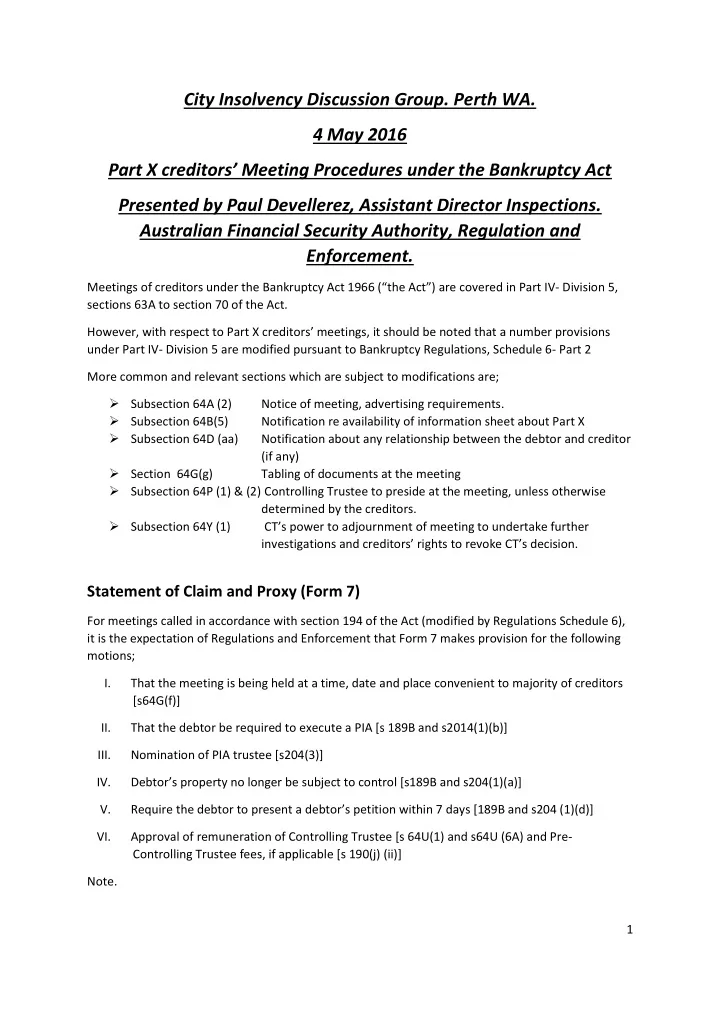

City Insolvency Discussion Group. Perth WA. 4 May 2016 Part X creditors’ Meeting Procedures under the Bankruptcy Act Presented by Paul Devellerez, Assistant Director Inspections. Australian Financial Security Authority, Regulation and Enforcement. Meetings of creditors under the Bankruptcy Act 1966 (“the Act”) are c overed in Part IV- Division 5, sections 63A to section 70 of the Act. However, with respect to Part X creditors’ meetings, it should be noted that a number provisions under Part IV- Division 5 are modified pursuant to Bankruptcy Regulations, Schedule 6- Part 2 More common and relevant sections which are subject to modifications are; Subsection 64A (2) Notice of meeting, advertising requirements. Subsection 64B(5) Notification re availability of information sheet about Part X Subsection 64D (aa) Notification about any relationship between the debtor and creditor (if any) Section 64G(g) Tabling of documents at the meeting Subsection 64P (1) & (2) Controlling Trustee to preside at the meeting, unless otherwise determined by the creditors. Subsection 64Y (1) CT’s power to adjournment of meeting to undertake further investigations and creditors’ rights to revoke CT’s decision. Statement of Claim and Proxy (Form 7) For meetings called in accordance with section 194 of the Act (modified by Regulations Schedule 6), it is the expectation of Regulations and Enforcement that Form 7 makes provision for the following motions; I. That the meeting is being held at a time, date and place convenient to majority of creditors [s64G(f)] II. That the debtor be required to execute a PIA [s 189B and s2014(1)(b)] III. Nomination of PIA trustee [s204(3)] IV. Debtor’s property no longer be subject to control [s189B and s204(1)(a)] V. Require the debtor to present a debtor’s pet ition within 7 days [189B and s204 (1)(d)] VI. Approval of remuneration of Controlling Trustee [s 64U(1) and s64U (6A) and Pre- Controlling Trustee fees, if applicable [s 190(j) (ii)] Note. 1
Regulation published an article on Part X creditors’ meetings in Se ptember 2014 issue of the Personal Insolvency Regulator. Time for calling meeting (Section 193) Meeting must be held no more than 25 working days after the effective date of the section 188 authority; or If the effective date of the section 188 authority is in December- not more than 30 working days after the relevant effective date. “Working Day” is defined as not a Saturday, Sunday or a public holiday “in the place where the meeting is to be held” [S194(3)] Resolution for Personal Insolvency Agreement.(Section204) Possible special resolutions for consideration at the meeting are; a) Require the debtor to execute personal insolvency agreement. b) Require the debtor to present debtor’s petition within 7 days or c) Debtor’s property be no longer subject to control under Division 2-Part X of the Act. Comments. If resolution (a) is passed- No further resolution needs to be put to the meeting. If resolution (a) is rejected, motion for resolution (b) should be put to the meeting for voting. It is suggested that resolution (c) is put to the meeting for voting regardless of whether the resolution (b) was accepted or rejected by the creditors. Where resolutions (a) and (b) are rejected, the debtor’s affairs will continue to be subject to control by the trustee for a period of 4 months after the date the section 188 authority became effective[section 189(1A)(d)] unless otherwise determined by the creditors as per resolution(c)- [Section 189(1A)(a)]. Voting by separate classes of creditors. Where a PIA involves joint and separate estates with joint and several creditors, it is important to ensure that special resolutions as required are properly passed by each class of creditor in order for the debtor’s proposal to be accepted. In Williams Ex parte; The Official Trustee in Bankruptcy, 26 FCR 191, it was held that a meeting of joint and separate creditors the following rules apply with respect to voting rights of different classes of creditors; a) Separate creditors shall not vote on a resolution proposed for consideration by joint creditors; b) Joint creditors shall not vote on a resolution proposed for consideration by separate creditors; and 2
c) Joint and several creditors may vote on resolution proposed for joint creditors and on resolutions proposed for separate creditors. On a practical note, when a section 189A report is sent to the creditors, the controlling trustee should advise the creditors about the special resolution requirements at the creditors’ meeting. The report should also include the estimated return to each class of creditor under a bankruptcy scenario in the event that the debtor’s proposal is not accepted by the creditors. 3
Recommend
More recommend